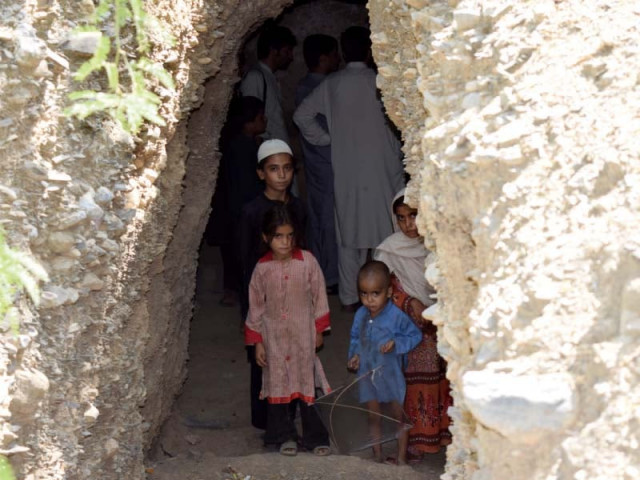There and back again: Carving homes in Khyber Agency’s caves
Many residents spend specific periods of times in them

Children peek through the cave’s entrance. PHOTO: EXPRESS
“I couldn’t afford to construct a house for myself immediately when we migrated from Tirah,” he added.
After spending June and July in the cave, he has now shifted to a mud house. It becomes difficult to live in the house during severe cold and hot weather and Amal and his family most live there during spring and autumn. The cave is the family’s haven when extremities in the weather system become the order of the day.
Beyond anachronism
The caveman is widely believed to be a stock character that is based on anachronistic ideas. However, Amal’s life in the cave does not mirror an old-world charm. A quick walk through the cave reveals that the family has opted for the arrangement out of sheer necessity. Although the cave has an old wooden door, Amal has stored mattresses, pillows and burning wood in the cave. He uses these items during winter.
Amal has two sons and four daughters. There are 13 family members in his family who need to be taken care of.
However, he feels living in the cave becomes difficult during heavy rain as water makes its way into the family’s cavernous home.
“But there is no threat of snakes, scorpions while living in the cave.”
Customs and traditions
There is a diverse menu of reasons why people choose to spent time in caves in the area. The practice, which is locally called gaara, has prevailed for the last 50 years. There are around 250 caves in various localities of Khyber Agency. Some, like Amal, live in the caves while others use them as extra storage space.
Many locals spend the night in cave as power failures remain rampant in the agency.
Momin Khan, an elder who lives near Amal, told The Express Tribune he only uses his cave during June and July as one can easily spend the night inside the cave without a fan.
He has a well-furnished home but enjoys living in the cave as it is a traditional practice. “The cave is hot in winter while cold in summer.”
The caves are dug out at a higher altitude without use of concrete, bricks, stones or binding material while some of them are natural. Some people have divided them into small rooms and added kitchens and cupboards. Locals use solar panels as alternative sources of electricity both in homes and these ancient caves.
Momin has also installed two solar panels connected with a single fan and three solar lights inside the cave.
Momin said the caves in Khyber Agency also became homes for the displaced families of Tirah valley bordering Nangarhar province of Afghanistan. The caves subsequently became the base of hardcore militants when army operations first began.
“We have provided shelter to many displaced families of Tirrah when the operation began,” recalls Momin. He added these caves were used by IDPs families with minimum number of family members.
Rewind
Talking about the historical background of these caves, Manzoor Afridi, an elder of Khyber Agency believes the caves were created by the British during World War I and were used as an entrenchment against the German forces.
“British were also using these caves as an arms depot to store weapons to fight against German forces,” he said.
Furthermore, he said the caves were used by the locals as a trench. According to Afridi, locals would hide in them and when caravans of British forces used to pass through Khyber Agency, they would loot them and confiscate goods.
Published in The Express Tribune, September 13th, 2016.












COMMENTS
Comments are moderated and generally will be posted if they are on-topic and not abusive.
For more information, please see our Comments FAQ